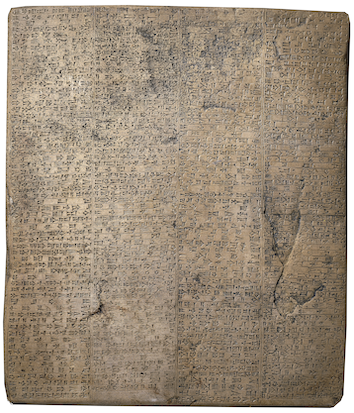Ezibatila (temple of Gula at Borsippa)
According to Akkadian inscriptions of the Neo-Babylonian ruler Nebuchadnezzar II (r. 604–562 BC), including the "East India House Inscription," the healing goddess Gula/Ninkarrak had three temples at Borsippa. Ezibatila was one of those three; the other two were Egula and Etila.

BM 129397, a large stone tablet that bears a long Akkadian inscription that is now commonly referred to as the "East India House Inscription." The description of Nebuchadnezzar's rebuilding of Ezibatila is recorded in lines iv 52–56. Image adapted from the British Museum Collection website. Credit: Trustees of the British Museum.
Names and Spellings
This temple at Borsippa went by the Sumerian ceremonial name Ezibatila; the precise meaning of the name is uncertain. A ritual fragment refers to this temple as Ezidabatila.
- Written Forms: e₂-zi-ba-ti-la ; e₂-zi-da-ba-ti-la.
Known Builders
- Neo-Babylonian (ca. 625–539 BC)
- Nebuchadnezzar II (r. 604–562 BC)
Building History
In numerous Akkadian inscriptions, Nebuchadnezzar II states that he built Ezibatila anew. This work was carried out in connection with the rebuilding of two other temples of Gula/Ninkarrak at Borsippa, Egula and Etila. Presently-extant inscriptions provide no information about this Neo-Babylonian king's work on Ezibatila.
Archaeological Remains
Ezibatila has not yet been positively identified in the archaeological record.
Further Reading
- George, A.R. 1993. House Most High. The Temples of Ancient Mesopotamia (Mesopotamian Civilizations 5), Winona Lake, p. 159 no. 1234.
Jamie Novotny & Joshua Meynell
Jamie Novotny & Joshua Meynell, 'Ezibatila (temple of Gula at Borsippa)', Babylonian Temples and Monumental Architecture online (BTMAo), The BTMAo Project, a sub-project of MOCCI, [http://oracc.org/btmao/Borsippa/TemplesandZiggurat/Ezibatila/]